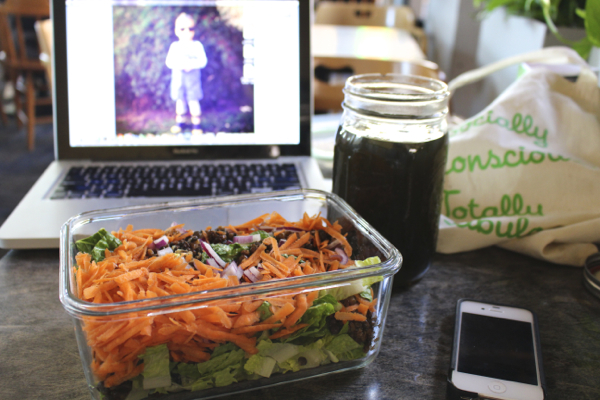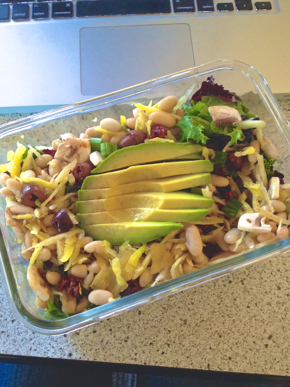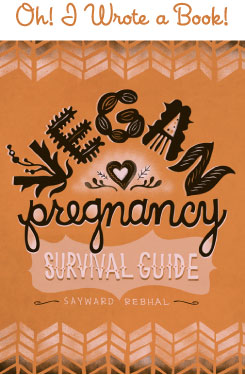I love salad. I always have, for as long as I can remember. I haven’t always been vegan and I certainly haven’t always eaten healthy, but salad? Salad has always been my jam.
Even back in grade school when they would serve hot lunch on Fridays, and all the kids would line up to receive their plate, I would always get to the end and squeak, “Extra salad, please!” Back then it was some cheap mix of iceberg and romaine, a few sad carrot shreds, and some over-processed Costco vat of partially hydrogenated Italian dressing. But even so, I would go back for seconds, every time. I loved that salad.
So flashing forward many years, and my salads look a whole lot different than they did back then (thank goodness!) It’s taken me years to perfect the art of the salad, and to be able to construct a meal-sized serving every day that keeps me sated and going strong into the evening. Which is what I do, for lunch, almost every single week day.
While working with my Vegan Lifestyle Coaching clients, I quickly learned that many of you, out there on your own, have been trying to crack the salad code. You want to eat salad for lunch (or dinner), but every time you try, you find that you’re hungry just an hour or two later. So by the next meal, you’re ravenous and you overeat to overcompensate. Which sucks – I know ’cause I’ve been there.
The good news, my friends, is that constructing a salad is just simple science. Straightforward mathematics. And here, I’m going to share with you everything that I know about the subject.
So buckle up y’all. This here’s gonna be a long one (no but really, really long) (so if you’re in a hurry, skip on to the end for a super mini summary!)
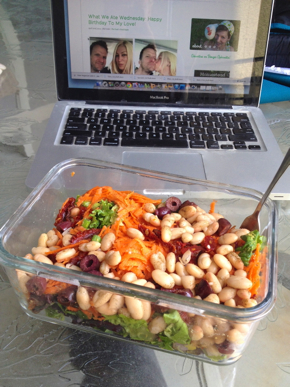
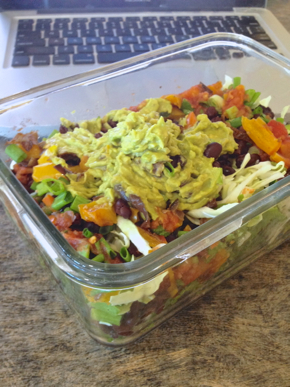
The Science Of Salad
Proper salad construction is a five-part equation, simple as that:
(greens) + (veggies/toppings) + (protein/legumes) + (fat) + (dressing) = a meal-sized salad
So let’s go through each of these one by one, and I’ll give you the “why” and the “how” as well as my best budget-friendly and time-sensitive tips. Sound good?
~ ♥ ~ Greens ~ ♥ ~
The base of any salad worth it’s salt (sea salt, of course!), greens are where we start. As far as nutrient density goes, you simply can’t beat greens. From spicy arugula to crunchy romaine, massaged and wilted kale to the modern salad darling, the mesclun mix, each variety of greens offers it’s own unique and fantastic nutrient profile. Stick with your very favorite, or mix and match each week for maximum nourishing potential! And don’t forget non-traditional salad greens such as thin-sliced red and white cabbage (I love these in my Mexican- or Asian-inspired salads), tender hardy greens like baby chard or baby kale (awesome in Mediterranean-style salads) or even shredded brussels sprouts or broccoli slaw (best when paired with a perky, flavorful dressing).
But before we continue here, a quick aside . . .
Greens will make up the bulk of your salad, and although greens are nutrient-rich, they are calorie poor. So you’ll want to include plenty of them! A real meal salad is sizable. You may need to adjust your expectations of what the volume of your lunch is supposed to look like. I know it can seem intimidating to dig into something so large, but I promise you – the number one reason people fail at the salad game, end up feeling haaaangry pains, and thus give up all together, is because they’re just too afraid to commit to a truly enormous salad. But you gotta do it! Trust me.
Every morning I pack up my 8-cup Glasslock container. I use this one and I LOVE IT. It is large and in charge, made of glass and easy to clean, and the perfect vessel for my daily dose of salad love.
Another option is to pack up the various salad parts in smaller (more standard-sized) containers and then construct it once you’re at work. Recently, Jeremy and I found a giant ceramic bowl for him to keep at his office for just such a purpose. He goes to the grocery store once a week, fills the fridge at work with all his salad fixins, and then dumps them all right in the bowl as needed.
I eat at school so I don’t have that option, which means it’s Glasslock for me. For you, you’ll have to figure out what works. Either way, giant container or giant bowl, the key point here is: GIANT!
Okay, so back to greens! There are a couple of different options as far as buying and preparing go. Here’s my best tips for . . .
Budget-Friendly Options
Skip the pre-washed, pre-cut, and individually bagged mixes. Aside from baby spinach or arugula, which is harder to find loose, these packages often cost quite a bit more as opposed buying the whole head and doing the washing and tearing yourself. My favorite lettuces of all are only sold as whole heads: red leaf and heirloom butter varieties. So I buy a lot of lettuce heads! Next time you’re at the store or even the Farmer’s Market, compare the price-to-weight ratio of the whole heads versus the packaged salad bags. You can save a lot of dough here!
Time-Sensitive Tips
Okay, so it’s a weekday morning and time is of the essence. The thought of washing and drying lettuce leaves is not so appealing! Which is why it pays to put in the prep time.
If you go with the whole-head as opposed to the bagged option, then the first thing you should do when you get home from the grocery store is give it a good wash. Invest in a large salad spinner (check local thrift shops, garage sales, or Craigslist to find a cheap used one) and clear out a space in the fridge. When you get your lettuce home, peel off each leaf, rinse them all, and cram ‘em in the spinner (tear in half if you need). Then spin dry, leave them sitting in the spinner, and put the whole thing in the fridge. Voila! Now each morning, you’ll be able to grab a handful of leaves from the spinner, tear them into your container, and you’ll be good to go. The leaves will last a week or so like this in the fridge – if you’re eating a salad every day for lunch, you’ll eat a spinner-full of lettuce faster than it could go bad.
Another true time-saving option is, of course, the pre-washed salad bags. No shame here! We are all busy people living big, busy lives. I always tell my clients – if the convenience of buying the bags is what makes it possible for you to eat salads every day, then my goodness – buy the bags! Lord knows I do. Do what works for you, in your life.
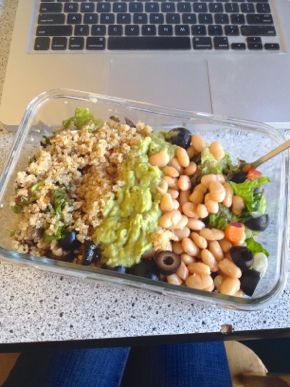
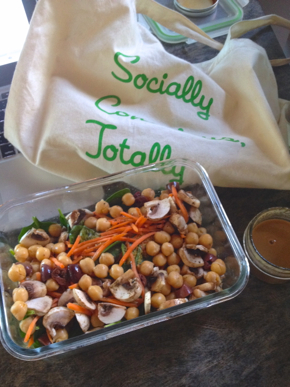
~ ♥ ~ Other Veggies and Toppings ~ ♥ ~
This is where you get to play, to really bring your salad to the next level using the endless abundance of amazing plant-based toppings. Any raw veggies. Any roasted veggies! Baked squash or sweet potato. Leftover side veggies from the night before. Jarred or canned toppings like green or kalamata olives, sun-dried tomatoes, artichoke hearts, capers, hearts of palm, roasted red peppers, pepperoncini, etc. And don’t forget fresh fruit, dried fruit, nuts and seeds (no they do NOT count as protein!) (unless they’re peanuts) (and even then, only if it’s at least 1/3 cup), and flavor enhancers like nutritional yeast, Herbamere, or kelp/dulse flakes/powder.
I definitely have my favorites when it comes to salad toppers. For example, in the pictures in this post you’ll notice a few things are almost constant. Exhibit A: grated carrot.
Sliced or chopped carrots in a salad? I could care less. But grate that puppy up, and I am in LOVE! Something about grating really releases all the moisture, making carrots this perfectly crunchy, crispy, delicious addition to my salads. Grating a whole carrot (peel on, rinsed) takes about 30 seconds. It’s so quick and easy, and the grater is surprisingly easy to wash (I just run it under water, no soap required. I do this every day.)
And for 79ç for a bag of whole organic carrots at Trader Joe’s, they really have become an indispensable salad staple.
Exhibit B: Green onions. Also cheap, incredibly easy to dice up real quick each morning, and they just add that amazing allium-y goodness without being overpowering the way that other onions can be. I LOVE green onions.
And another quick aside . . .
One of the keys to a really satisfying salad, at least for me, is the addition of umami. An umami salad really does feel like a whole meal – it carries that weight, that grounding element.
And what is umami? Well, it’s the fifth flavor profile! Along with “sour”, “bitter”, “salty”, and “sweet”, “umami” is essentially the flavor of savoriness. It’s rich and earthy and totally complex.
Most veggies are not umami. And in fact, a lot of traditional vegan food lacks umami, which is, I think, why many people find classic “vegan food” sort of bland or underwhelming. That’s a little tangential and a discussion for another day, but if you’re interested, The Vegan RD wrote an awesome piece entitled Is Umami A Secret Ingredient Of Vegan Activism?. Definitely worth a read.
Anyway, almost every salad I eat tends toward umami, and I really do think it’s why they work so well for me. I know some people like sweet salads and salad dressings, but I urge you to enter the umami zone, if only to give it a little try. Some common umami ingredients include: mushrooms, vinegars (especially wine and balsamic), tamari, tomatoes, nutritional yeast, sea veggies, olives and other brined foods, sauerkraut and other fermented foods, etc.
Okay, umami plug over.
Obviously, when it comes to salad topping combinations, the list is literally infinite. If you’re looking to cut time and/or money, here are some suggestions . . .
Budget-Friendly Options
Know thy produce. Pay attention everywhere you go, and compare the prices. Those 79ç carrots at TJs are a steal! They’d be three times that price at my Farmer’s Market. But avocados? Way cheaper at the FarMar. Same goes for sprouts and greens. And nutritional yeast is actually cheapest (around here) at Whole Foods of all places, in the bulk bins. So scout around, know what to grab from where, and you’ll really be able to save.
Time-Sensitive Tips
Here is where prepping ahead can really help you. Like I said above, grating a carrot real quick in the morning is negligible. But all that chopping of all those veggies for an entire salad? Well that can be daunting.
You have two options. First, you can shave time by buying pre-cut when possible. Pre-sliced mushies, broccoli florets, cherry tomatoes, etc. Buying canned and jarred items also cuts down on prep time since they’re already small (in order to fit in the jar/can). Capers, peppers, pickles, etc are all great options that will add tons of flavor (umami!) to your salads, while also saving those precious morning minutes.
The other option is prep. When you buy your veggies, take them home, wash them, and then cut them. Investing the time up front in one big chunk is economical, especially if you can make the time do double duty by catching up on your favorite podcasts, audiobooks, or TV shows (yes, bring that cutting board to the couch and chop chop chop on your coffee table!) Keep each ingredient – minced onions, shredded beets, sliced cucumber, cubed bell peppers, etc, wrapped in a wet paper towel in a sealed container (they’ll keep like this for a week or so). Then, each morning you’ll just have to grab a handful from each one, and you’ll be good to go!
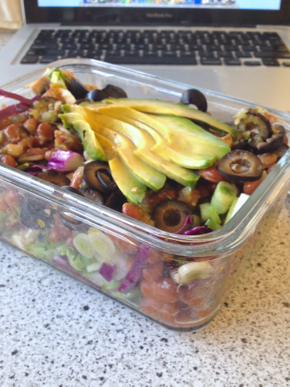
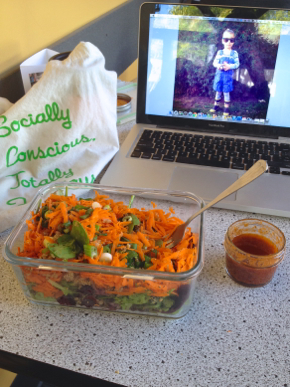
~ ♥ ~ Protein / Legumes ~ ♥ ~
Where do you get your protein?
Are you rolling your eyes? You shouldn’t be! EVERYbody, regardless of diet, should be including concentrated sources of protein in their meals. So when omnis make a salad, they usually choose eggs, or cheese, or meat to hit that spot. Why do we as vegans think that we can remove those foods, but not replace them?
You’re going to tell me that everything has protein, especially those greens we’re using as the foundation of our salad. Which is true, in a technical, un-useful sort of way. There’s a reason omnis add eggs or cheese or meat instead of just relying on that kale and a sprinkling of sunflower seeds (NOT enough protein, my bunny rabbit buddies). And that’s because, as we already talked about, greens (and all those other veggies) are calorie light! They’re full of fiber, and water, and if you wanted to eat enough greens to meet your entire protein requirement, your tummy would pop and your jaw would ache from the chewing.
Okay, so maybe that’s a bit of hyperbole, but seriously. You’re not going to get enough protein from your greens and veggies or even a few tablespoons of nuts or seeds. You need vegan sources of concentrated protein, just like omnis “need” omni sources of concentrated protein. That doesn’t make veganism inferior, okay?
Protein, most often in legume form, makes you feel full. It provides lasting energy. It gives you a sense of satiety, and adds “staying power” to your meal. Protein is important, and as far as I’m concerned, it’s an absolutely integral part of a salad.
And why legumes? Because legumes are high in lysine, which makes them “complete” in a way that some other sources of plant-based protein are not. Now before you jump on me, I know that food-combining-for-complete-proteins has been debunked, and I know that our bodies disassemble proteins into their building blocks, amino acids, and then reassemble them as needed. Trust me, I’m the girl who developed protein depletion on a vegan diet, so I assure you – I know. I’ve spent a LOT of time researching this topic (which is why I know that it’s so contentious, and man I’m just bracing myself for the outrage I’ll receive for even daring to suggest that vegans need to think about protein – I mean the horror!)
So without getting too tangential (too late!), if vegans don’t eat enough legumes we can fall short on lysine, which means that even though our bodies are disassembling, there won’t be enough of all the right building blocks when reassembly time comes. Make sense? You can read a more comprehensive discussion of this topic here, on The Vegan RD.
So. Legumes, and their protein-dense counterpart the “pseudograins” (which also contain nice high levels of all essential amino acids including lysine), will give your salad that gut-sticking gravity that you’re looking for. Legume options include lentils (probably my fave), all beans (like black, pinto, navy, kidney, etc) hummus (but a lot, not just a few tablespoons), falafel, tofu (mmmm leftover tofu scramble is SO GOOD on salad), and tempeh. Pseudograin superstars include quinoa, buckwheat, and amaranth.
Budget-Friendly Options
When it comes to saving scrilla, you can’t beat dried beans in the bulk bins. Yes, it takes a bit of planning and forethought. But if you can get it down, especially if you can develop a system, you can save big bucks. Buy your beans or pseudograins in bulk, then prepare a big batch over the weekend (or over night in the crock pot). Keep them in a container in the fridge, stealing a scoop for your salad each day. Freeze the extras in smaller portions so that over time you can build up a back stock of variety. Then, all you’ll have to do is pull out a different jar to thaw over night, and you’ll get a new bean or grain every few days.
Time-Sensitive Tips
Planning?? Forethought??? Surely you jest!
But seriously, that’s the sort of stuff I was able to do back in Portland and it was awesome. Anyone who has the time and the wherewithal, it’s well worth it. But these days, these grad school with a 4-year-old and on-my-own days, I can barely keep track of my own fleeting thoughts.
Canned beans to the rescue! Soooo many of my clients feel guilt, this weird internalized shame, over buying canned beans and pre-cooked lentils (the ones in the cold case at Trader Joe’s are my life’s blood, I swear. Those lentils are amaaaazing), like it makes them a bad hippie for not buying dried bulk goods. To which I say:
Man! We are being too hard on ourselves! We are all just doing our best.
I know you, and I see that you are really doing the very best you can do.
Canned beans are not a crime against humanity. Good lord, buy the beans and save yourself the stress!
~ ♥ ~ Fat ~ ♥ ~
Just like protein, fat can also be a controversial subject among vegans. So I will just speak for myself (and every one of my clients who I’ve ever worked on this with – anecdotal but worth noting I’d say, because yeah, every. single. one.) when I say that fat is the thing that makes a salad stick until dinner time. Protein is key, but fat is really the clincher. And sooo many people, especially women, try to leave off all the fat. No wonder we’re all walking around starving and fighting cravings!
I love fat in all its (unrefined) forms, and happily eat it up. But even if you’re in the low-fat or no-oil camp, you can add healthy, whole foods-based fat sources to pump up the satiety factor of your salads. Avocado is easy and delicious, and it’s super duper healthy. Nuts and seeds come into play here, adding richness and texture while contributing all sorts of important micronutrients (hello, zinc!)
I also love to add olives which are relatively high in fat for what they are, and I adore me some extra virgin olive oil-packed sun-dried tomatoes. Yes please. Oh, and coconut bacon!
Budget-Friendly Options
Plant-based whole foods fat sources (now that’s a mouth full!), like avocados and nuts, do tend to be expensive. Avocados are so healthy and delicious, so when you catch them on sale, make sure you take advantage.
Nuts are usually more expensive than seeds, so, for example, choose sunflower seeds, pumpkin seeds, and flax seeds over almonds, walnuts, or cashews.
Time-Sensitive Tips
Fat’s easy, no time-input required!
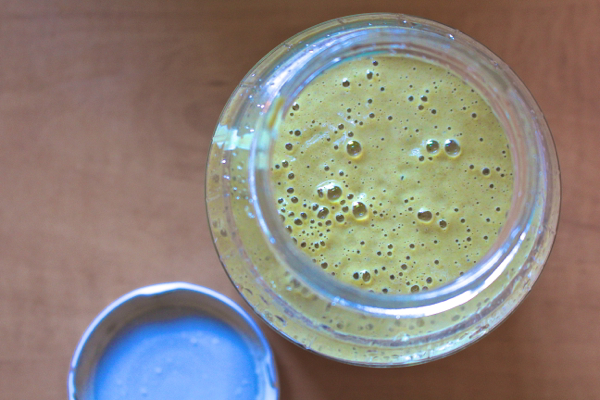
~ ♥ ~ Dressing ~ ♥ ~
Dressing is the pièce de résistance of any proper salad. The right dressing elevates those veggies, takes your salad from a disjointed collection of parts to a unified cohesive commune of YUM. Dressing is the bomb and you need to find a dressing you adore.
Dressing comes in all shapes and sizes. They can be oily or oil-free, nut butter-based or bean-based, light with vinegar or thick with cashew cream. They can be homemade or store-bought. Thick like a dip, or delightfully light like vinaigrette. It doesn’t matter really, as long as you find one that you love. Because finding the right dressing is what’s really going to make you craaaaave a salad!
Budget-Friendly Options
The most cost-effective dressings are homemade, of course. I suggest making one or two batches each weekend so you have them on hand, easy access, all week. Most of these last at least a week (maybe even 2) in the fridge. Some of my favorites:
The Tahini Dip That Done Stoled My Heart
Or, one of my secret weapons: hummus thinned with a little vinegar or lemon juice and water!
Or, if you prefer not to make dressings ahead of time, you can whip up a quick vinaigrette in the morning while you compose your salad. This is what I do roughly 95% of the time. And vinaigrettes are easy, soooo easy, no recipe required. Mine usually include red wine vinegar and either dijon mustard or nutritional yeast to thicken them, maybe a crushed clove of garlic (breath alert!), and I very rarely add oil. That’s just my preference.
What I do add is a bit of a dirty secret. I’m actually nervous to admit it because I think you’ll think I’m such a weirdo! But here goes: olive juice. True story! The brine from kalamata olives is an awesome addition to my vinaigrettes (and actually, sometimes from canned black olives, but that’s only for certain types of salads). Brine is salty and flavorful, brimming with umami. I’ve also used green olive juice, brine from marinated mushrooms, sauerkraut juice, etc. Are you giving me the side-eye?
But I’m a girl who loves a LOT of flavor. If you like things lighter, lemon juice is great. A little olive oil and lemon juice can go a long way. Rice wine vinegar is milder too, and a little sweet. Flavored vinegars are also fun!
Whatever you prefer, the point is that it’s super quick and easy to throw together a 2- or 3-ingredient vinaigrette each morning. I put mine in a small mason jar, shake to mix, and keep it separate until I’m ready to eat.
Time-Sensitive Tips
On the flip-side, if you’re all about saving time, then store bought is the way to go. There are a ton of amazing, whole foods-based salad dressings available out there. Check for local brands (co ops and FarMars are great for this) to find the healthiest and most delicious available, like the drool-inducing tomato balsamic I pick up at this awesome little hippie restaurant in the next town over.
If you don’t have access to anything like that, nationwide brands like Follow Your Heart are pretty widely available.
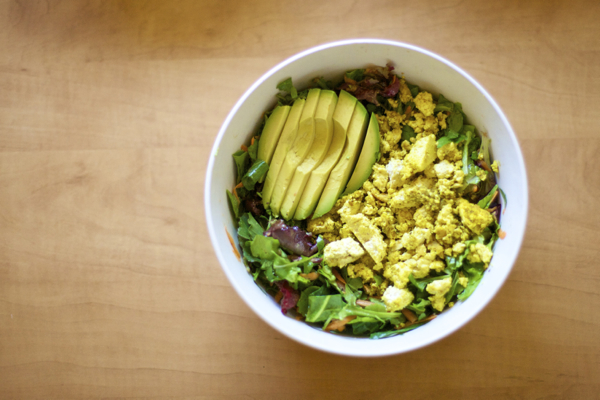
And that, my friends, is pretty much everything I know about the science and the art of salad construction. So . . .
To Summarize
A proper, serve-as-a-meal, keep-you-full salad has five major components:
1. The greens. Bagged or head lettuce, spinach or romaine or arugula or baby spring mix, it doesn’t matter. Make greens the foundation of your salad, and make sure there are a lot of them. Your container should be GIANT.
2. Veggies and Other Toppings. Raw vegetables, cooked vegetables, canned and jarred goods, fermented foods, sea veggies, nutritional yeast, whatever you like. Mix it up and don’t forget umami!
3. Protein / Legumes. Beans like black, pinto, navy, kidney, plus other legumes like lentils and soy foods. And don’t forget those honorary legumes, the pseudograins! These include quinoa, buckwheat, and amaranth.
4. Fat. You need fat to keep you feeling full, for sure. Don’t be afraid of healthy fat! Avocados, nuts, seeds, olives, and extra virgin olive oil-packed preserves are all awesome choices.
5. Dressing. Whether it’s homemade or store bought, finding a dressing that you crave is the thing that will keep you coming back to salads. So find one you love, and keep it in stock.
Aaaaaaand, I’m spent. Whew!
-
http://thiskindchoice.com/ Emma – thiskindchoice.com
-
Bon
-
http://www.thevegancookiefairy.com/ The Vegan Cookie Fairy
-
http://windycityvegan.wordpress.com/ Monika {windycityvegan}
-
http://www.theveganchickpea.com theveganchickpea
-
Kendra
-
Meg
-
Angie
-
Emily
-
chantel
-
Carol Morgan Cox
-
http://thegreenpenn.blogspot.com LIndsey at TheGreenPenn
-
Lacy Davis
-
http://marfigs.wordpress.com/ Marfigs
-
http://eerosa.com erosan
-
http://windycityvegan.wordpress.com/ Monika {windycityvegan}
-
http://bonzaiaphrodite.com/ Sayward Rebhal
-
http://bonzaiaphrodite.com/ Sayward Rebhal
-
http://bonzaiaphrodite.com/ Sayward Rebhal
-
Jared Bigman
-
Sarah C.
-
amber
-
Sarah C.
-
Melissa Ferrante
-
Ginny Messina
-
http://bonzaiaphrodite.com/ Sayward Rebhal
-
http://bonzaiaphrodite.com/ Sayward Rebhal
-
http://bonzaiaphrodite.com/ Sayward Rebhal
-
http://bonzaiaphrodite.com/ Sayward Rebhal
-
http://bonzaiaphrodite.com/ Sayward Rebhal
-
http://bonzaiaphrodite.com/ Sayward Rebhal
-
http://bonzaiaphrodite.com/ Sayward Rebhal
-
http://bonzaiaphrodite.com/ Sayward Rebhal
-
http://bonzaiaphrodite.com/ Sayward Rebhal
-
http://bonzaiaphrodite.com/ Sayward Rebhal
-
http://bonzaiaphrodite.com/ Sayward Rebhal
-
http://bonzaiaphrodite.com/ Sayward Rebhal
-
http://bonzaiaphrodite.com/ Sayward Rebhal
-
http://bonzaiaphrodite.com/ Sayward Rebhal
-
http://bonzaiaphrodite.com/ Sayward Rebhal
-
http://bonzaiaphrodite.com/ Sayward Rebhal
-
http://bonzaiaphrodite.com/ Sayward Rebhal
-
http://eerosa.com erosan
-
http://eerosa.com erosan
-
Gemma
-
Lynn
-
veganinbrighton
-
Sarah C.
-
Candice
-
Rebecca Carnes
